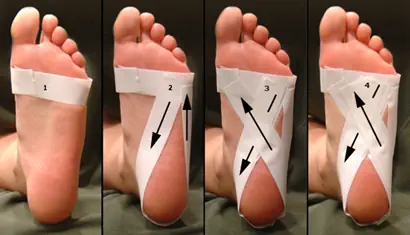Plantar Fasciitis: Causes, Symptoms, and Treatment Options for Pain Relief

What is Plantar Fascia?
The plantar fascia is a thick piece of tissue at the bottom of the feet that connects the toes to the heel bone and supports the arch of your foot. Plantar fasciitis occurs when the plantar fascia is strained and inflamed. You may experience persistent, intense pain at the bottom of your foot.
This condition typically affects individuals who stand, jump, or run for prolonged periods. Most people with this type of heel pain recover within a year, even if they are not given specific treatment.
Plantar Fasciitis Symptoms
- Pain at the bottom of the foot and under the heel.
- Pain is worst in the morning after getting out of bed or after a long period of rest. However, the pain subsides within a few minutes of walking.
Plantar Fasciitis Risk Factors
Several factors can increase your risk of developing plantar fasciitis:
- Being overweight.
- Anatomical factors, such as having flat feet or high arches.
- Wearing unsuitable footwear, such as high heels or tight shoes, for a prolonged period may put excess stress on the plantar fascia.
- Excessive use of the foot in activities such as hiking, walking, dancing, or running extremely long distances on uneven surfaces or downhill.
- Having medical conditions such as type 2 Diabetes Mellitus, psoriatic arthritis, and ankylosing spondylitis.
Plantar Fasciitis Diagnosis
To diagnose plantar fasciitis, your doctor would first question your general health and symptoms before conducting a thorough physical examination.
Diagnosis is made based on your reported symptoms, physical examination, and investigations.
Depending on the nature and degree of pain and other factors, your doctor may recommend X-ray or a magnetic resonance imaging (MRI) scan to determine if other conditions are causing the heel pain.
Plantar Fasciitis Treatment
Most individuals with plantar fasciitis do not require specific treatment since the condition improves on its own. However, some may require treatment for pain management.
- Rest and limit any athletic activities to allow for extra rest and relief of symptoms.
- Ice the area for at least 20 minutes a day, up to 4 times a day, to relieve pain.
- Commonly used medications are nonsteroidal anti-inflammatory drugs (NSAIDs) such as ibuprofen, paracetamol, and naproxen. Topical NSAIDs may also be used.
- People with plantar fasciitis often experience intense pain while taking the first few steps in the morning, mainly due to the sudden pressure on the fascia. Using night splints helps prevent the sudden stress of the first few steps in the morning.
- Use athletic shoes or arch-supporting shoes, or shoes with gel pad inserts or heel cups to temporarily alleviate pain.
- If you experience pain in your affected foot first thing in the morning, "low-Dye taping" may be helpful.
- A steroid injection in your foot can help relieve pain fast. However, the effects are temporary and wear off after a few weeks.
- Surgery is only recommended if other treatment methods have been ineffective at relieving pain.
- Guided physiotherapy can effectively reduce stress in the heel and improve foot biomechanics.
Exercises for Plantar Fasciitis
The following are some easy exercises recommended for managing pain associated with plantar fasciitis.
- Standing calf stretch
- Lean against a chair that you position in front of yourself.
- Extend one leg behind you until you feel a stretch.
- Bend out the other leg slightly in the front.
- Hold for a few seconds and return to the starting position.
- Gastrocnemius muscle stretch
- Use a wall as support for this exercise and place your foot flat on the floor.
- Keep one leg straight, and lean forward, reducing the angle between your foot and shin until a stretch is felt in the calf muscle in the leg you have placed behind.
- Hold this position for 1 minute, remembering not to let your heel leave the floor.
- Tennis ball/frozen bottle rolling
- Sit comfortably on a chair and place your bare foot on a tennis ball.
- Roll the tennis ball forward and backward for 1 minute.
- If you do not have a tennis ball, the next best thing to do is take a filled-up bottle and freeze it. Once frozen, wrap it with a towel to prevent ice burn.
- Then, repeat the same steps as for the tennis ball.
- Sitting exercise
- Sit with the affected leg crossed over the unaffected leg.
- Hold the toes of the affected leg and bend them backward until you feel a stretch in the sole of your foot.
- Make sure to hold the stretch for 1 minute.
- Standing exercise
- Place the front of your foot and toe against a wall.
- Then, lean forward and hold for 1 minute.
Plantar Fasciitis Prevention
You can take preventive measures to manage plantar fasciitis pain such as:
- Avoid standing for extended periods.
- Avoid wearing uncomfortable shoes.
- Limit intense activities such as mountain climbing, trekking, and running.
- Avoid walking barefoot on hard surfaces.
Make an appointment at Gleneagles Hospitals
If you are experiencing any of the symptoms of plantar fasciitis, get in touch with us to find out more about our Orthopaedic Services at your nearest Gleneagles Hospital.
Gleneagles Hospital works with orthopaedic specialists to assist patients through diagnosis and treatment. The caring and multidisciplinary team of healthcare professionals is available for consultation and to provide the best care.


